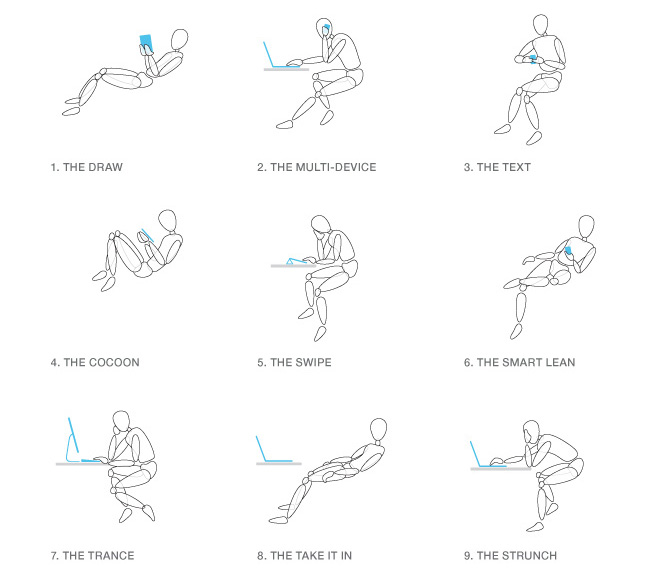A survey released by Steelcase offers a startling glimpse into how we use devices at work – and how we might ‘strunch’ over them. If you’re wondering why your back is aching, read on.
Having surveyed 2000 people across 11 countries, Steelcase uncovered nine working postures which it links directly to new technologies and workplace behaviours.
It evaluated how the human body interacts with technologies and how it responds as workers shift from one device to another. The research revealed ergonomic implications that Steelcase warns “can cause pain and discomfort for workers”.
Their 9 postures are:
- 1. The Draw: A relaxed position, pushing back on a flexible chair, device held up in front of your face, feet on the floor.
- 2. The Multi-Device: Leaning forward over a desk or table, often with a smartphone to your ear and a laptop or tablet in front.
- 3. The Text: Legs crossed, eyes down, holding a smartphone (and probably texting).
- 4. The Cocoon: Curled up in a relaxed position, feet up, head craned forward to read or browse.
- 5. The Swipe: Hunched over a table, one hand swiping a tablet, the other supporting your head.
- 6. The Smart Lean: Kicking back in a chair, leaning to one side with a device in one hand, the other draped casually over an armrest.
- 7. The Trance: Bent over a desk, gazing into a computer screen, head supported on one hand, the other controlling a mouse or trackpad.
- 8. The Take-It-In: Leaning back, reading a screen from a distance, absorbing every word.
- 9. The Strunch: Sitting at coffee table level, hunched over, reading from a laptop or tablet.

Relaxing and comfortable? Or an orthopedic disaster waiting to happen?
Technology is empowering our working lives in ways never before believed possible – but it comes at a price.
“Because these new postures are not adequately supported, workers are uncomfortable, in pain, and doing long-term harm to their bodies,” says Steelcase. “While technology boosts productivity, it can cause pain that disrupts our work, our ability to concentrate, and our creativity.”
The report also found that workers use their devices – smartphones, laptops or tablets – up to 6 hours each day for work. For many people, the reality is much more.
To combat the time bomb effect that’s created by a combination of long hours, handheld technology and poor posture, Steelcase has itself developed a new range of office furniture to support posture changes influenced by technical devices.
Most business centre operators already provide ergonomic chairs that conform to current health and safety guidelines. But is it enough? Some high-end workspace operatives are quick to invest in the next generation of furniture that’s developed specifically for today’s technology. Yet perhaps the responsibility lies with your clients, who simply need to scrap the strunch and sit a little straighter.
Which way do you ‘lean’?


 Dr. Gleb Tsipursky – The Office Whisperer
Dr. Gleb Tsipursky – The Office Whisperer Nirit Cohen – WorkFutures
Nirit Cohen – WorkFutures Angela Howard – Culture Expert
Angela Howard – Culture Expert Drew Jones – Design & Innovation
Drew Jones – Design & Innovation Jonathan Price – CRE & Flex Expert
Jonathan Price – CRE & Flex Expert












